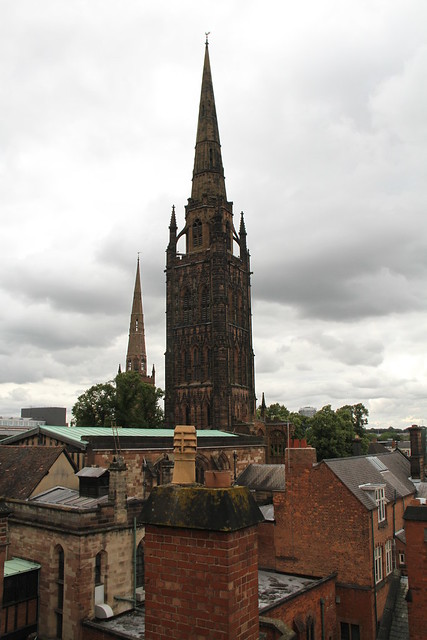The exterior of the Council House
The building is faced with Runcorn stone and roofed in Cotswold stone. The rich display of heraldic carvings mostly centred around the main entrance includes the arms of many historical characters associated with Coventry's history, from the time of Edward the Confessor until the 16th Century.
The full list is: Edward the Confessor; Henry II; Queen Isabella; Edward III; Edward, the Black Prince; Richard ll; Henry VI; Queen Margaret; Queen Elizabeth l; Mary, Queen of Scots; James l; the Earls of Chester, Cornwall and Northampton; the Dukes of Norfolk and Hereford; Neville, Earl of Warwick; Sir William Dugdale; Thomas Sharp; John Hales; Sir Thomas White; the Botoners and Swillingtons; Thomas Wheatley; Thomas Bond; William Ford; Dr Philemon Holland; the Davenports: the Hopkins and Jesson families; Sir Skears Rew; the Harringtons of Coombe Abbey; the Berkeleys of Caludon Castle; the City of London; and the See (bishopric) of Lichfield and Coventry.
This is the list published in the programme to the official opening, but when the devices were repainted in the 1950s, it was found that Ford and Rew were not among them but another - Beauchamp, Earl of Warwick - was.
The other main features of the exterior are the corner clock tower and the statues of Godiva, Leofric and 'Justice' above the entrance, plus smaller figures elsewhere on the building. These were actually not present when the building was opened, although spaces had been left for them. They were not added until 1925-26. The architects, after consulting the Council, had commissioned Henry Wilson to provide the figures in 1924. Wilson had previously been responsible for making the stalls and canopies in the Council Chamber, and supervising other carving.
The smaller figures include Edward the Confessor; Edward, the Black Prince; and Ranulf, the Earl of Chester. The four figures at the clock tower's corners are the four patron saints of the British Isles (although originally they were to be the 'angels of the four winds). The figure at the top of the clock tower has been thought to represent many people, from St George to a boy scout (!), but is actually St Michael (the archangel described in the Bible), with a flaming sword, keeping watch over the city. The clock mechanism was made by John Smith & Sons of Derby, but the outer casing (featuring the figure and wings of an angel) seems to have been part of the general architectural scheme for the building and may have been designed by H. VV. Simister, who the Corporation asked to make suggestions for modifying the clock in 1926. Internal lighting was added in May 1925, by the Coventry Electrical & Engineering Company. The clock was damaged during an air raid in 1941, but the full extent of the damage was only discovered in the autumn of 1959. The design was altered slightly when repairs were carried out, at a cost of around £1,400. The clock is wholly mechanical, with no electrical parts at all.


